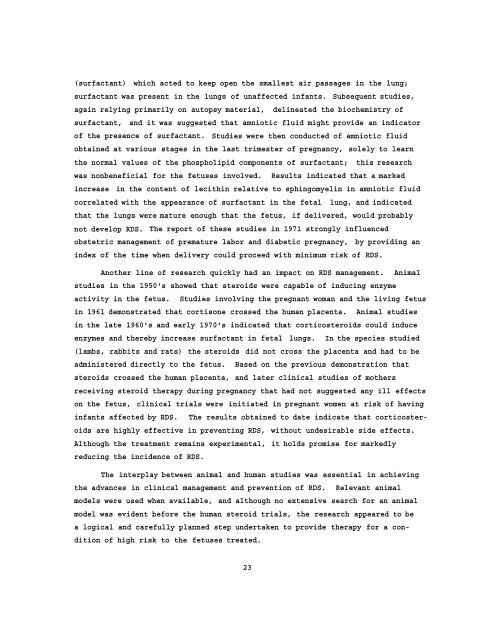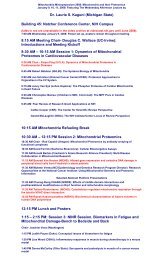RESEARCH ON THE FETUS - National Institutes of Health
RESEARCH ON THE FETUS - National Institutes of Health
RESEARCH ON THE FETUS - National Institutes of Health
Create successful ePaper yourself
Turn your PDF publications into a flip-book with our unique Google optimized e-Paper software.
(surfactant) which acted to keep open the smallest air passages in the lung;<br />
surfactant was present in the lungs <strong>of</strong> unaffected infants. Subsequent studies,<br />
again relying primarily on autopsy material, delineated the biochemistry <strong>of</strong><br />
surfactant, and it was suggested that amniotic fluid might provide an indicator<br />
<strong>of</strong> the presence <strong>of</strong> surfactant. Studies were then conducted <strong>of</strong> amniotic fluid<br />
obtained at various stages in the last trimester <strong>of</strong> pregnancy, solely to learn<br />
the normal values <strong>of</strong> the phospholipid components <strong>of</strong> surfactant; this research<br />
was nonbeneficial for the fetuses involved. Results indicated that a marked<br />
increase in the content <strong>of</strong> lecithin relative to sphingomyelin in amniotic fluid<br />
correlated with the appearance <strong>of</strong> surfactant in the fetal lung, and indicated<br />
that the lungs were mature enough that the fetus, if delivered, would probably<br />
not develop RDS. The report <strong>of</strong> these studies in 1971 strongly influenced<br />
obstetric management <strong>of</strong> premature labor and diabetic pregnancy, by providing an<br />
index <strong>of</strong> the time when delivery could proceed with minimum risk <strong>of</strong> RDS.<br />
Another line <strong>of</strong> research quickly had an impact on RDS management. Animal<br />
studies in the 1950's showed that steroids were capable <strong>of</strong> inducing enzyme<br />
activity in the fetus. Studies involving the pregnant woman and the living fetus<br />
in 1961 demonstrated that cortisone crossed the human placenta. Animal studies<br />
in the late 1960's and early 1970's indicated that corticosteroids could induce<br />
enzymes and thereby increase surfactant in fetal lungs. In the species studied<br />
(lambs, rabbits and rats) the steroids did not cross the placenta and had to be<br />
administered directly to the fetus. Based on the previous demonstration that<br />
steroids crossed the human placenta, and later clinical studies <strong>of</strong> mothers<br />
receiving steroid therapy during pregnancy that had not suggested any ill effects<br />
on the fetus, clinical trials were initiated in pregnant women at risk <strong>of</strong> having<br />
infants affected by RDS. The results obtained to date indicate that corticosteroids<br />
are highly effective in preventing RDS, without undesirable side effects.<br />
Although the treatment remains experimental, it holds promise for markedly<br />
reducing the incidence <strong>of</strong> RDS.<br />
The interplay between animal and human studies was essential in achieving<br />
the advances in clinical management and prevention <strong>of</strong> RDS. Relevant animal<br />
models were used when available, and although no extensive search for an animal<br />
model was evident before the human steroid trials, the research appeared to be<br />
a logical and carefully planned step undertaken to provide therapy for a condition<br />
<strong>of</strong> high risk to the fetuses treated.<br />
23











